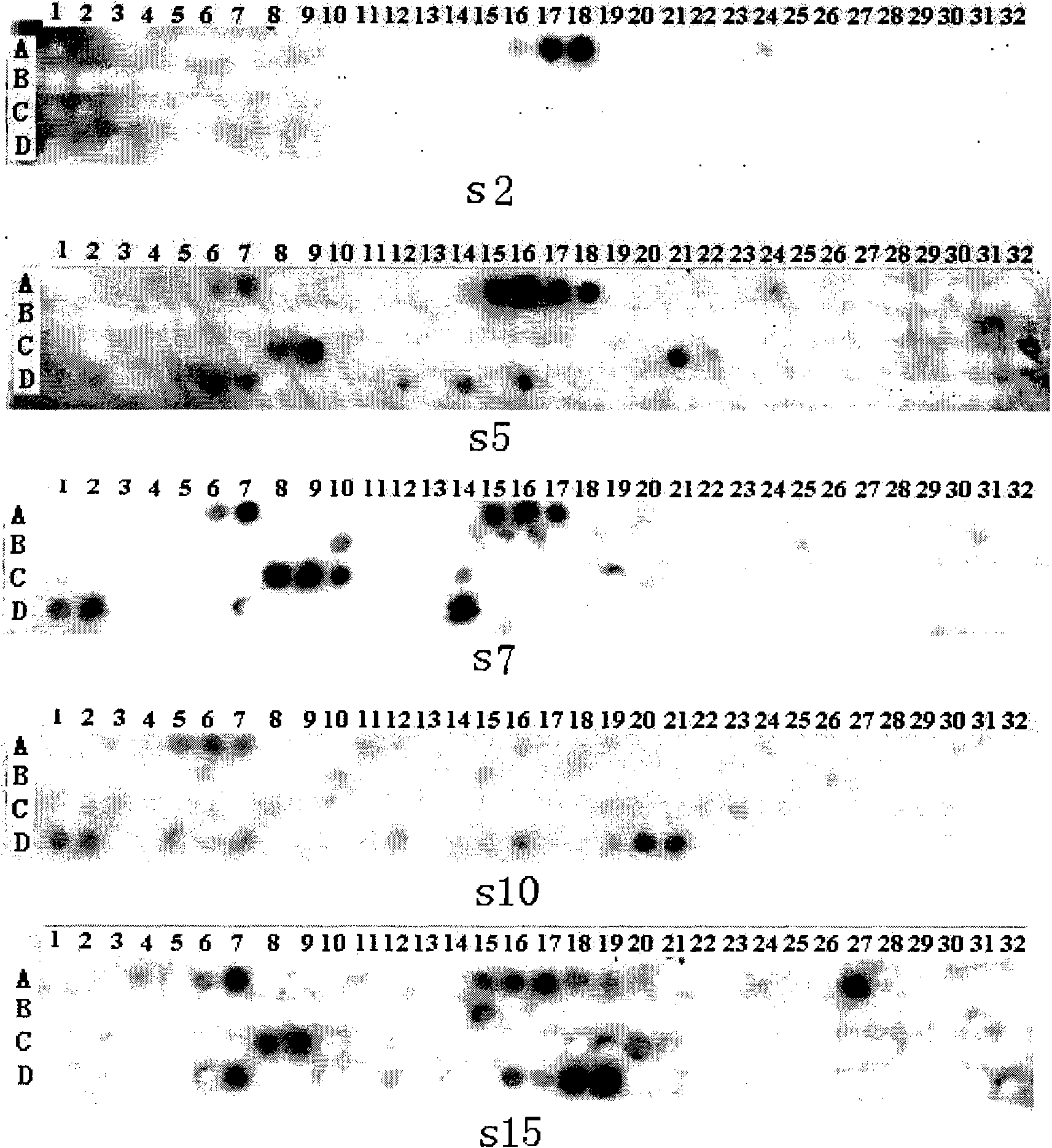Antigen peptide identified by p53 antoantibody, kit and application thereof in preparing tumor detection kit
An autoantibody, antigen polypeptide technology, applied in the fields of peptides, measuring devices, instruments, etc., can solve the problems of high purification difficulty and high cost of kits, and achieve the effect of simple preparation method, not easy to degrade, and lower use cost.
- Summary
- Abstract
- Description
- Claims
- Application Information
AI Technical Summary
Problems solved by technology
Method used
Image
Examples
Embodiment 1P53
[0071] Example 1 Screening of linear antigen sequences recognized by P53 autoantibodies
[0072] 1. The specific implementation steps of the screening process of the core sequence:
[0073] According to the amino acid sequence of p53 protein, the 12-peptide peptide chip was synthesized on the surface of activated cellulose membrane by point synthesis technology at intervals of 3 amino acids. Because the wild-type p53 protein contains 393 amino acid residues, its full length includes 128 12-peptide polypeptide chains overlapping 9 amino acid sequences, that is, the polypeptide array includes 128 spots. Therefore, the peptide array we designed is 32×4, that is, there are 32 points in each row and 4 points in each column, such as figure 1 shown.
[0074] According to the operating instructions of the ASP SL peptide synthesizer, put 20 FMOC-group-protected natural amino acid solutions into the corresponding positions on the machine. After the predetermined program is input int...
Embodiment 2p53
[0099] Determination of embodiment 2p53 polypeptide core sequence
[0100]In order to determine the core sequences of the polypeptides of SEQ ID No.1, SEQ ID No.2 and SEQ ID No.3, the inventors used two methods: 1. Based on the full-length sequence, one amino acid was sequentially reduced from the N-terminus and C-terminus of the polypeptide Synthetic series of peptides. The core sequence used to determine the sequences shown in SEQ ID No.1 and SEQ ID No.3. 2. For the sequence of SEQ ID No.2, the inventors used the 4-12 synthetic peptide library method based on the 21-peptide polypeptide sequence containing the core sequence to determine its core sequence. Incubate the synthesized series of polypeptides with positive serum according to the above-mentioned experimental method, and develop color to determine the core sequence of the polypeptide. Two experimental methods successfully determined the core sequences of the three polypeptides. All experiments also showed that the ...
Embodiment 3
[0118] Embodiment 3 The preparation and use method of p53 kit of the present invention
[0119] Those skilled in the art can entrust a biological company to complete the synthesis of the polypeptide described in the present invention. This example was synthesized by Shanghai Huada Tianyuan Biotechnology Co., Ltd.
[0120] 1. Preparation of kits
[0121] 1. Synthesize the antigenic polypeptide according to the above core sequence.
[0122] 2. Dilute the antigenic polypeptide to 10 μg / ml with 0.05M, pH 9.0 carbonate coating buffer, add 0.1ml to the reaction well of each microtiter plate, and leave overnight at 4°C. The next day, the solution in the well was discarded, and washed 3 times with washing buffer, 5 minutes each time.
[0123] 3. Dry and seal for storage.
[0124] Preparation of reagents:
[0125] 1. Wash buffer (PH7.4PBS 20×): 3M
[0126] K H 2 PO 4 0.2 grams
[0127] Na 2 HPO 4 12H 2 O 2.9 g
[0128] NaCl 8.0g
[0129] KCl 0.2 g
...
PUM
 Login to View More
Login to View More Abstract
Description
Claims
Application Information
 Login to View More
Login to View More - R&D
- Intellectual Property
- Life Sciences
- Materials
- Tech Scout
- Unparalleled Data Quality
- Higher Quality Content
- 60% Fewer Hallucinations
Browse by: Latest US Patents, China's latest patents, Technical Efficacy Thesaurus, Application Domain, Technology Topic, Popular Technical Reports.
© 2025 PatSnap. All rights reserved.Legal|Privacy policy|Modern Slavery Act Transparency Statement|Sitemap|About US| Contact US: help@patsnap.com



